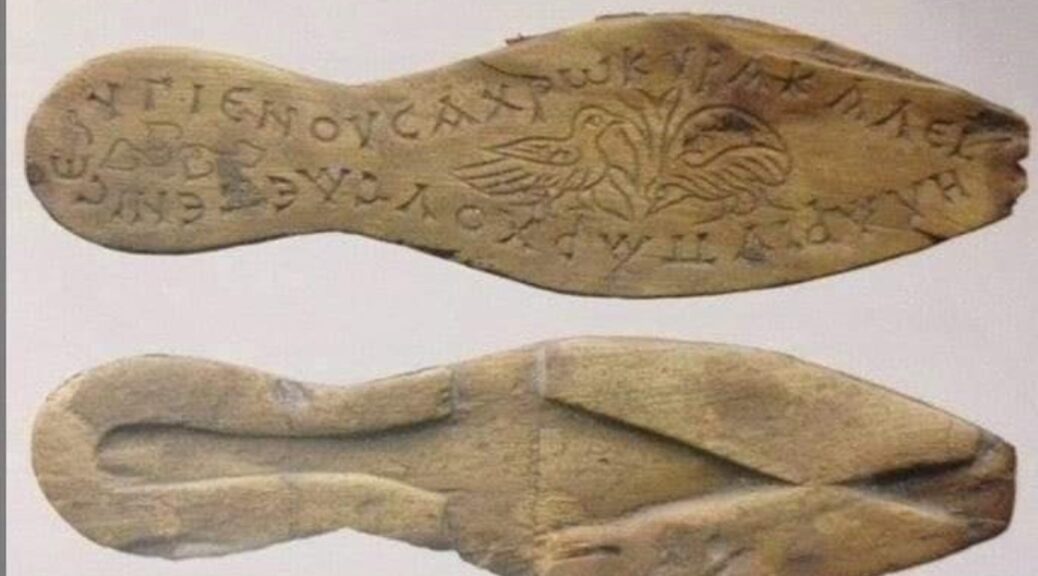The 1,500-Year-Old Byzantine Sandals with Sweet Message in Greek

A pair of Byzantine sandals uncovered during an excavation in Istanbul has become one of the city’s most popular exhibits at the archaeological museum. The sandals have a message in Greek which reads: “Use in health, lady, wear in beauty and happiness.”
The astonishing find was discovered during digs prompted by the Marmaray project, the undersea railway tunnel connecting the Asian and European sides of Istanbul under the Bosporus.
The excavations, which started in 2004, have revealed new historical aspects of Constantinople, the capital of the Byzantine Empire.
Some 60,000 artefacts unearthed over a span of around nine years are being preserved in Istanbul Archeological Museum until a special museum is built for them, the Turkish newspaper Daily Sabah reports.
The Byzantine Empire was the continuation of the Roman Empire in its eastern provinces during Late Antiquity and the Middle Ages. It survived the fragmentation and fall of the Western Roman Empire in the 5th century AD and continued to exist for another thousand years until it fell to the Ottoman Empire in 1453. During most of its existence, the empire was the most powerful economic, cultural, and military force in Europe.
Byzantine sandals belonged to a woman
Scientists say that the sandals discovered are more than 1,500 years old and they belonged to a woman.
The Byzantines loved colour and patterns, and they made and exported very richly patterned cloth, especially Byzantine silk, which was woven and embroidered for the upper classes and resist-dyed and printed for the lower.
Modesty was important for all, and most women appeared to be almost entirely covered by rather shapeless clothes.
There has been a considerable amount of footwear recovered in this excavation project, with sandals, slippers and boots to the mid-calf seen commonly in manuscript illustrations also found in the dig. Many of the items are richly decorated in various ways.
The colour red, reserved for Imperial use in male footwear, is actually by far the most common colour for women’s shoes. Purses are rarely visible and seem to have been made of textile matching the dress, or perhaps tucked into the sash.

Istanbul excavations reveal gems from the Byzantine Empire
The excavations have found the first traces of civilizations from different periods, including the skeletons of the first Istanbulites; 8,500-year-old footprints’ the Harbor of Eleutherios (Theodosius), a port known in world literature but with no traces having been found previously; and the world’s largest medieval sunken ship collection, as well as 60,000 animal bones of 57 species along with plant fossils.
The Harbor of Eleutherios, which was one of the ports of ancient Constantinople, is located beneath the modern Yenikapi neighbourhood of Istanbul. It was built at the mouth of the Lycus River, which ran through the city to the Propontis.
The harbour was built in the late 4th century, during the reign of Theodosius I, and was the city’s major point of trade in Late Antiquity. It continued to be used until the 11th century.
Silt from the Lycus eventually filled the harbour entirely and the area was later transformed for agricultural use due to the effects of upstream erosion and deposition. In Ottoman times, the area was entirely built over.
READ ALSO: A PAIR OF GOLDEN SANDALS FOUND IN KING TUTANKHAMUN’S TOMB THAT SHOWS HOW EGYPTIAN SANDALS WERE MADE
In November 2005, workers on the Marmaray project discovered the silted-up remains of the harbour.
Excavations produced evidence of the 4th-century Portus Theodosius. There, archaeologists uncovered traces of the city wall of Constantine the Great, and the remains of over 35 Byzantine ships from the 7th to 10th centuries, including several Byzantine galleys, remains of which had never before been found.

In addition, the excavation has uncovered the oldest evidence of settlement in Constantinople, with artefacts, including amphorae, pottery fragments, shells, pieces of bone, horse skulls, and nine human skulls found in a bag, dating back to 6000 BC.
